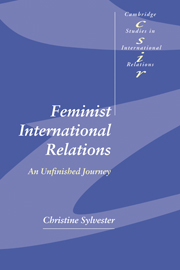Book contents
- Frontmatter
- Contents
- Acknowledgments
- Part I Introduction
- Part II Sightings
- 3 Handmaids' tales of Washington power: the abject and the real Kennedy White House
- 4 Reginas in international relations: occlusions, cooperations, and Zimbabwean cooperatives
- 5 The White Paper trailing
- 6 Picturing the Cold War: an eye graft/art graft
- 7 Four international Dianas: Andy's tribute
- Part III Sitings
- Part IV Citings
- References
- Index
- CAMBRIDGE STUDIES IN INTERNATIONAL RELATIONS
5 - The White Paper trailing
Published online by Cambridge University Press: 22 September 2009
- Frontmatter
- Contents
- Acknowledgments
- Part I Introduction
- Part II Sightings
- 3 Handmaids' tales of Washington power: the abject and the real Kennedy White House
- 4 Reginas in international relations: occlusions, cooperations, and Zimbabwean cooperatives
- 5 The White Paper trailing
- 6 Picturing the Cold War: an eye graft/art graft
- 7 Four international Dianas: Andy's tribute
- Part III Sitings
- Part IV Citings
- References
- Index
- CAMBRIDGE STUDIES IN INTERNATIONAL RELATIONS
Summary
“White” developed out of more travel, this time to Australia in the mid-1990s, when I took up sequential visiting appointments at the Australian National University (in the Department of International Relations, Research School of Pacific and Asian Studies, and then in the Department of Political Science in the Faculties). At that time, there was concern in critical (IR circles of the country that the government was about to issue a retrogressive defense strategy–a White Paper–for a new era. I was only vaguely aware of this planning when Graeme Cheeseman, of the Australian Defence Forces Academy (ADFA), asked me to write on gender aspects of the Paper for a volume of critical essays. I was nowhere near the right person for the job: I had little knowledge of Australia and much less sense of its defense history and policies. Furthermore, the very thought of reading an official defense document made me go pale with ennui; military policy is not “my thing.” Graeme insisted, and so I stuffed the Paper into a bag as I headed for a vacation at the south coast. In pristine Moruya, New South Wales–ocean front and estuary back–I read the dread Paper. Techno-garbley, it mentioned women in only two short, obviously prescribed, sections.
The raison d’être behind the White Paper was fear that the United States could no longer be relied on to defend Australia's regional interests in the post-Cold War era.
- Type
- Chapter
- Information
- Feminist International RelationsAn Unfinished Journey, pp. 106 - 121Publisher: Cambridge University PressPrint publication year: 2001



